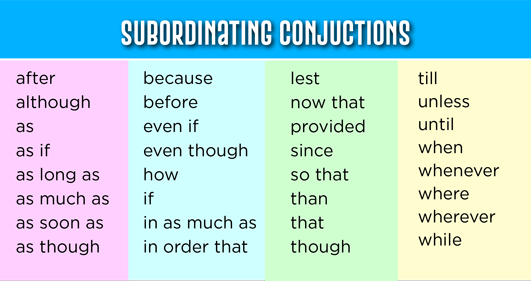วันนี้เราจะมานำเสนอ Subordinating Conjunction หรือ คำสันธานที่ใช้เชื่อมประโยคย่อยไม่อิสระ/ประโยคใจความรอง (dependent/subordinate clause) ประเภท adverb clause เข้ากับประโยคย่อยอิสระ/ประโยคใจความหลัก (independent/main clause) ใน complex sentence เพื่อแสดงความสัมพันธ์ในลักษณะต่าง ๆ อาทิ กิริยาอาการ สถานที่ เวลา เหตุผล ผล จุดประสงค์ การขัดแย้งหรือแตกต่างกัน การเปรียบเทียบ คำสันธานในกลุ่มนี้ เช่น as if, in a way that, where, wherever, when, before, because, since, so that, so, although, whereas, as … as, more … than, if, unless เป็นต้น โดยคำเชื่อมเหล่านี้จะเป็นส่วนหนึ่งของประโยคย่อยไม่อิสระและมีเครื่องหมายจุลภาค , (comma) คั่นระหว่างประโยคทั้งสอง

1) ข้อความแสดงลักษณะอาการ (manner)
เป็นการอธิบายลักษณะอาการหรือเพิ่มเติมข้อมูลเกี่ยวกับลักษณะการกระทำในประโยคใจความหลัก คำสันธานที่ใช้ เช่น as (ตามที่), in a/the way that (แบบ/ตามวิธีการแบบ), like (เหมือนกับ), unlike (ไม่เหมือนกับ), as if/as though (ราวกับว่า) เป็นต้น
- Please submit the report by January 16 as I requested earlier.
- He handled the situation in the way that I like.
- Like every other student, Ladda had difficulty with tenses.
- It looks as if it will rain tonight.
- Mary acted as though she saw a ghost.2) ข้อความแสดงสถานที่ (place)
เป็นการอธิบายขยายความการกระทำ/เหตุการณ์ในประโยคใจความหลัก เพื่อให้ทราบว่าเกิดขึ้นที่ใด คำสันธานที่ใช้ เช่น where (ที่ที่), wherever (ที่ใดก็ตามที่) เป็นต้น
- Put this document where it belongs.
- We will accompany you wherever you go.
3) ข้อความแสดงเวลา (time)
เป็นการอธิบายขยายความการกระทำ/เหตุการณ์ในประโยคใจความหลัก เพื่อให้ทราบว่าการกระทำ/เหตุการณ์ในประโยคนั้นเกิดขึ้นเมื่อใด ก่อนหรือหลังการกระทำ/เหตุการณ์ใน adverb clause คำสันธานที่ใช้ เช่น as/while (ขณะที่), as soon as (ทันทีที่), since (ตั้งแต่), until/till (จนกระทั่ง), when (เมื่อ), whenever (เมื่อใดก็ตามที่), before (ก่อนที่), after (หลังจากที่), soon after (ภายหลังไม่นาน) เป็นต้น
- The woman slipped as she was getting off the train.
- While we are considering your request, you should prepare all necessary documents.
- I’ll leave for the funeral as soon as the meeting ends.
- The ASEAN summit has been postponed until the present crisis is over.
- When the rain stops, we’ll go out.
- Before you make your payment, you should contact our finance office.
- You’ll feel better after you’ve had some rest.
- I’ll come soon after I’ve finished my work.
4) ข้อความแสดงเหตุผล (reason)
เป็นการอธิบายขยายความเกี่ยวกับเหตุผลของการกระทำ/เหตุการณ์ในประโยคใจความหลัก คำสันธานที่ใช้ เช่น as/since/because (เพราะว่า) เป็นต้น
- As I was feeling tired, I went to bed early.
- I see my parents quite often as they live near me.
- Since we had nothing better to do, we watched television the whole evening.
- We decided to go out for a meal since there wasn’t anything to eat in the house.
- Because it was raining heavily, I had to take a taxi home.
- I’m taking the English Grammar in Use course this semester because I want to be able to communicate in English more correctly and fluently.
5) ข้อความแสดงจุดประสงค์ (purpose)
เป็นการอธิบายขยายความว่าการกระทำ/เหตุการณ์ในประโยคใจความหลักมีจุดประสงค์ใด คำสันธานที่ใช้ เช่น so that/in order that (เพื่อที่) เป็นต้น
- I’ll give her my email address so that she can contact me.
- I spoke very slowly in order that the students could understand what I said.
6) ข้อความแสดงผล (result)
เป็นการอธิบายผลของการกระทำ/เหตุการณ์ในประโยคใจความหลัก คำสันธานที่ใช้ เช่น so (ดังนั้น), so … that/ such … that (มากจนกระทั่ง) เป็นต้น
- I have too much work to do, so I can’t go to my friend’s birthday party tonight.
- He worked so hard that he became ill.
- It was such lovely weather that we spent the whole day in the garden.
7) ข้อความแสดงความแย้งหรือตรงกันข้ามกัน (concession/contrast) เป็นการให้ข้อมูลที่แย้งหรือตรงกันข้ามกับการกระทำ/เหตุการณ์ในประโยคใจความหลัก คำสันธานที่ใช้ เช่น although/though/even though (ถึงแม้ว่า), while/whilst/whereas (ในขณะที่) เป็นต้น
- Although/Though/Even though it was cold, I went swimming.
- I like coffee while/whereas my husband likes tea.
8) ข้อความแสดงการเปรียบเทียบ (comparison)
เป็นการอธิบายเปรียบเทียบความต่างระหว่างการกระทำ/เหตุการณ์ใน adverb clause กับประโยคใจความหลัก คำที่ใช้ เช่น as … as (เท่ากับ), not as … as (ไม่เท่ากับ), -er/more … than (มากกว่า), -er/less … than (น้อยกว่า) เป็นต้น
- There’s plenty of food, so please eat as much as you like.
- Jane isn’t as old as she looks.
- The government has taken this current crisis more seriously than ever.
- I have fewer friends here than in my own country because I have less time to socialize (here than in my own country).
9) ข้อความแสดงเงื่อนไข (condition)
เป็นการอธิบายว่าการกระทำ/เหตุการณ์หนึ่งเป็นผลมาจากอีกการกระทำ/เหตุการณ์หนึ่งซึ่งเป็นเงื่อนไข โดย adverb clause เป็นส่วนที่แสดงเงื่อนไข และประโยคใจความหลักเป็นส่วนที่แสดงผลของการกระทำ คำที่ใช้แสดงเงื่อนไข เช่น if (ถ้า), unless (ถ้าไม่), as long as (ตราบเท่าที่) เป็นต้น ซึ่งประโยคเงื่อนไขและประโยคที่แสดงผลของเงื่อนไขมีโครงสร้างประโยคหลายแบบ (ดูโมดูลที่ 12 Complex Sentences: Adverb Clauses)
- Please do not hesitate to call me if you have further questions.
- If I could afford it, I would buy a house.
- Unless Tim hurries, he will miss the bus.
- You can use my car as long as you drive carefully.

